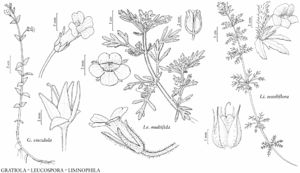Leucospora multifida
J. Acad. Nat. Sci. Philadelphia 7: 87. 1834.
Stems (4–)10–30(–41) cm, usually much-branched from base; branches spreading to ascending. Leaves 2 or 3(or 4) per node; blade ovate to triangular-ovate in outline, rarely lanceolate in outline, 8–30 × 4–23 mm, ultimate segments lanceolate to linear. Pedicels spreading to ascending, (1–)2–5 mm in flower, to 7 mm in fruit, glandular-villosulous. Flowers: calyx lobes slightly falcate, abaxial slightly shorter than adaxial, 2.6–4 × 0.4–0.7 mm; corolla glabrous, tube 2–3 mm, throat open, yellow or greenish yellow abaxially within, lobes 1 × 1 mm; stamens included; style 0.5–1 mm. Capsules ovoid, 4.5 × 1.8–2.3 mm. Seeds 0.3–0.4 mm, 8-ribbed, ribs longitudinal, straight.
Phenology: Flowering Jun–Nov.
Habitat: Sandy or silty shores of streams, lakes, and ponds, muddy or sandy bars, rocky intermittent stream beds, seeps, solution holes in rocks, wet places in urban areas.
Elevation: 0–600 m.
Distribution
Ont., Ala., Ark., Fla., Ga., Ill., Ind., Iowa, Kans., Ky., La., Mich., Miss., Mo., Nebr., N.J., N.Y., N.C., Ohio, Okla., Pa., Tenn., Tex., Va.
Discussion
As noted by F. W. Pennell (1935), populations of Leucospora multifida often are associated with calcareous substrates; populations also occur on other substrates. They occasionally are reported along railroads and in damp sites in parking lots in urban areas.
Selected References
None.
